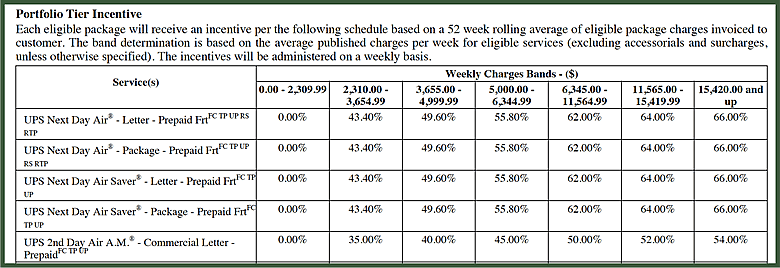This post is by Brian Gibbs, President of Refund Retriever.
What do most small businesses do when their shipping contract comes up for renewal? That’s right, they just resign themselves to rising prices and tougher terms, and sign on the dotted line.
It doesn’t have to be that way. Shipping is a competitive industry, and you can make carriers fight for your business. But how do you do that? FedEx and UPS each have very complicated contracts and it’s hard for online sellers to understand all the variables that exist within those terms.
Here’s how, through contract negotiations, shippers can lower their rates, reduce their shipping spend and improve profitability. There’s no reason for ecommerce merchants and online sellers of any kind to continue overpaying for freight and small parcel shipping.
The #1 factor when reviewing shipping contracts
Contracts – like all other factors that impact business operations – are influenced primarily by data.
Specifically, carrier contracts use data to identify the services that businesses depend on most. A business that depends on ground shipping, for example, has different needs than another business that depends more heavily on express. Residential vs. commercial final delivery and transportation also impact these businesses.
Countless other factors are often overlooked or misunderstood by small parcel shippers. Yet through data, these factors can clearly be identified and more easily understood. With the help of technology, the consequences of carrier contract terms can become clearer to shippers, which is invaluable for strengthening their contract terms.
Types of discount – and a catch
When analyzing contracts, it’s important to consider the two primary ways a shipper can save money. A guaranteed discount is one that will be applied to a shipment automatically while a volume-based incentive discount, also known as a tier discount, is based on shipping volume.

Volume-based discounts adjust as volume warrants. The more you ship, the higher the tier becomes and as a result, savings increase. If you fall below a certain tier, however, that percentage of savings could drop to zero. The complexity of this can be tricky for the naked eye to see, however. Often, there are minimum spend details that apply and as a result, many shippers don’t get a discount on the majority of the packages they send.
An example of this would be if a shipper sends a $10 ground package and has a 40% discount negotiated in their carrier contract – with the expectation to pay only $6.00. However a minimum net charge of $7.57 in their contract then kicks in. The majority of carrier agreements state that the customer agrees to pay the greater of the (a) net shipment charge after discount or (b) the minimum net shipment charge.
These details – among many others – are ultimately what allow carriers to gain profit where savings are deserved by shippers. To avoid this, carrier contract reviews and negotiations are in order!
Your shipping contract negotiations checklist
To help you understand carrier contracts, and strengthen your own contract terms, work through the ten-point checklist below. It’s going to take some time and effort, but the savings can be substantial. Don’t forget that every dollar you cut from your costs is one dollar more profit, without making a single extra sale.
1. Use data to identify your shipping usage
While this may seem like an obvious detail not to overlook, the main takeaway is this… Have a clear understanding of the zones and weights being shipped from your business.
This will help you understand what discounts may be available based on those details, and all the other details that can be identified by scrutinizing your data.
2. Identify accessorial charges and surcharges
There are countless “extras” that both UPS and FedEx apply to shippers, including additional handling, address correction, delivery area surcharge, delivery confirmation signature required, large package surcharge and even residential delivery surcharges based on specific locations.
Let data lead your understanding of shipping charges, and identify what fees are being used the most, then go after discounts for each of those. Your goal should be to get a discount on the most-used fees.
3. Understand how dimensional weight (DIM) impacts your contract
You need data to see how many packages are being charged for more weight than they truly are, because of their dimensional size.

Once you see this number, you have to find a good DIM factor that will allow a large percentage of your packages to be shipped at their true weight. Why not all of them? Well, if you ask for a DIM factor to cover 100%, the carrier will charge you more somewhere else to make it up.
4. Review the timeframe in your contract
Is there a specific time period set in place for your carrier terms?
Knowing these key details can help you look ahead and plan for stronger carrier contract planning. Push it to the top of your priority list well in advance so you don’t get caught without specific accessorial fee concessions or DIM reductions.
5. Have you given up the right to claim late package refunds?
When someone gives up this right they – very simply – lose money on late deliveries made by the carriers. They will lose the benefits that companies like Refund Retriever can provide in terms of data and claiming various delivery refunds.
Whether it’s fraudulent account activity, damaged packages, undelivered packages or other variables, shippers deserve refunds based on these carrier errors.
6. Invest in shipping analytics
The human touch alone simply can’t identify all the factors that impact your shipping spend.
Thanks to technology, however, you can gain clarity to your shipping overhead – including the strengths and weaknesses within it. Investing in ongoing shipping reports will allow a clear view of these core details at any time, and ultimately help you improve your carrier terms.
7. Set an exit strategy for your future carrier contract
As each year comes and goes, UPS and FedEx alike introduce changes to their existing pricing structure.
As a result, it’s important shippers have an exit strategy identified in their contracts so that if changes made impact their terms, they can make adjustments or get out of the contract entirely. The real takeaway here, though? Change will happen and you need to be prepared for it.
8. Use more than one carrier to strengthen your position
Incorporating a multi-carrier strategy into your shipping efforts offers a variety of benefits – including increased pick-up and delivery locations, enhanced transit times and more favorable rates.
UPS and FedEx know they compete with each other, so why not use this to your advantage in your negotiations, as well? Leverage these details to negotiate stronger contract terms based on hard facts and data.
9. Know your end goals
Do you want to save money? Ship more efficiently? Optimize dollars spent?
Understanding current shipping rates, common DIMs and ways to save money through parcel auditing are all valuable details to be armed with as you negotiate your next carrier contract. But don’t overlook your specific goals. Keep those key factors in mind throughout the negotiation process.
10. Remember: UPS and FedEx thrive on YOUR lack of data
Here’s the reality of this scenario… Carriers don’t want to give late delivery refunds to shippers and they don’t like the fact that the shipper can be armed with data to help them optimize their shipping strategy.
They much prefer for shippers to have a fuzzy view of their shipping data. Very simply, lack of data on the shipper’s part opens the door to increase corporate profits. Is that something you’re okay with?
Wrapping up
Carrier contract negotiations may not currently top your to-do list, but once armed with the right data and the right motivation (usually saving money!) it’s a no-brainer to push this to the top of your priority list.
Use data to help you navigate the fine-print of carrier contracts and optimize your shipping terms. Remember… while UPS and FedEx may lead the way in delivery, YOU lead the way in your own shipping management.
If you don’t know how to get at your shipping data, or are intimidated by the contract negotiation process, consider using a service like Refund Retriever to take some of the responsibility off your plate without compromising on your end goals.
This post was by Brian Gibbs, President of Refund Retriever, a company which audits shippers’ FedEx or UPS accounts for late deliveries and billing mistakes, using their own in-house technology.
Refund Retriever also provides contract negotiation services and shipping reports to help ecommerce businesses and other shippers reduce their shipping costs.

Very good article on ups shipping contract negotiations